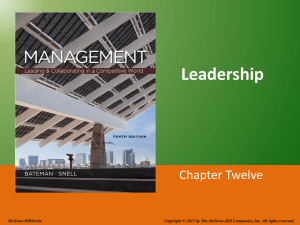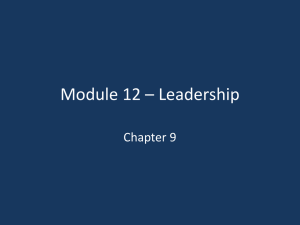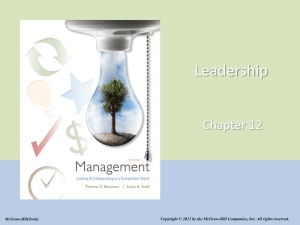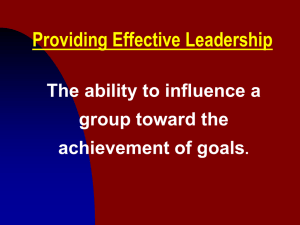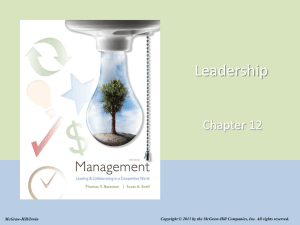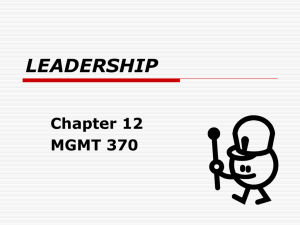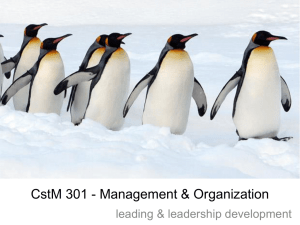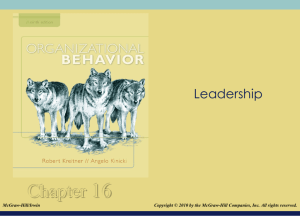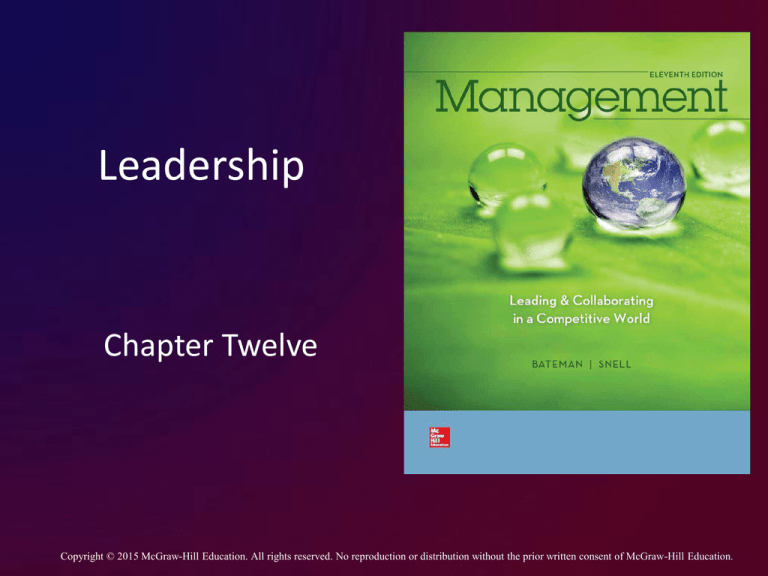
Leadership
Chapter Twelve
Copyright © 2015 McGraw-Hill Education. All rights reserved. No reproduction or distribution without the prior written consent of McGraw-Hill Education.
Learning Objectives
LO 1 Discuss what it means to be a leader
LO 2 Summarize what people want and what
organizations need from their leaders
LO 3 Explain how a good vision helps you be a better
leader
LO 4 Identify sources of power in organizations
LO 5 List personal traits and skills of effective leaders
12-2
Learning Objectives (cont.)
LO 6 Describe behaviors that will make you a better
leader and identify when the situation calls for
them
LO 7 Distinguish between charismatic and
transformational leaders
LO 8 Describe types of opportunities to be a leader in
an organization
LO 9 Discuss how to further your own leadership
development
12-3
Leadership
Leader
One who influences others to attain goals.
The greater the number of followers, the greater
the influence
12-4
Key Leadership Behaviors
1. Challenge the process
2. Inspire a shared vision
3. Enable others to act
4. Model the way
5. Encourage the heart
12-5
Vision
Vision
A mental image of a
possible and
desirable future state
of the organization.
12-6
Leading and Managing
Supervisory
leadership
Behavior that
provides guidance,
support, and
corrective feedback
for day-to-day
activities.
Strategic leadership
Behavior that gives
purpose and
meaning to
organizations,
envisioning and
creating a positive
future.
12-7
Question
___________ is the ability to influence others.
A. Innovation
B. Charisma
C. Power
D. Clout
12-8
Power and Leadership
Power
The ability to influence others.
12-9
Sources of Power
Legitimate
Coercive
Referent
Reward
Expert
12-10
Sources of Power
Figure 12.1
12-11
Traditional Approaches to
Understanding Leadership
Trait approach
A leadership perspective that attempts to
determine the personal characteristics that great
leaders share
12-12
Useful Leadership Characteristics
Drive
Leadership Motivation
Integrity
Self Confidence
Knowledge of the Business
12-13
Leader Behaviors
Behavioral approach
A leadership perspective that attempts to
identify what good leaders do—that is, what
behaviors they exhibit.
12-14
Leader Behaviors
Task performance behaviors
Actions taken to ensure that the work group or
organization reaches its goals.
12-15
Group Maintenance
Group maintenance
behaviors
Actions taken to
ensure the
satisfaction of group
members, develop
and maintain
harmonious work
relationships, and
preserve the social
stability of the group
Leader-Member
Exchange (LMX)
theory
Highlights the
importance of leader
behaviors not just
toward the group as
a whole but toward
individuals on a
personal basis.
12-16
Questions Assessing Task Performance
and Group Maintenance Leadership
Table 12.1
12-17
Question
Which leadership philosophy is characterized by
an absence of managerial decision making?
A. Autocratic
B. Democratic
C. Laissez-faire
D. Egalitarian
12-18
Participation in Decision Making
Autocratic leadership
A form of leadership in which the leader makes
decisions on his or her own and then announces
those decisions to the group
Democratic leadership
A form of leadership in which the leader solicits
input from subordinates.
12-19
Participation in Decision Making
Laissez-faire
leadership
philosophy
characterized by an
absence of
managerial decision
making.
12-20
Leadership Grid
Figure 12.2
12-21
Situational Approaches
to Leadership
Situational approach
Leadership perspective proposing that
universally important traits and behaviors do not
exist, and that effective leadership behavior
varies from situation to situation.
12-22
The Vroom Model of Leadership
Vroom model
Figure 12.3
A situational model
that focuses on the
participative
dimension of
leadership.
12-23
Situational Factors for
Problem Analysis
Table 12.2
12-24
Vroom’s Leader Decision Styles
Table 12.3
12-25
Fiedler’s Contingency Model
Fiedler’s contingency model of leadership
effectiveness
A situational approach to leadership postulating
that effectiveness depends on the personal style
of the leader and the degree to which the
situation gives the leader power, control, and
influence over the situation.
12-26
Fiedler’s Analysis of Situations
Figure 12.4
12-27
Fiedler’s Contingency Model
Task-motivated
Relationship-
leadership
motivated leadership
Leadership that
Leadership that
places primary
emphasis on
completing a task.
places primary
emphasis on
maintaining good
interpersonal
relationships.
12-28
Hersey and Blanchard’s
Situational Theory
Hersey and Blanchard’s situational theory
A life-cycle theory of leadership postulating that
a manager should consider an employee’s
psychological and job maturity before deciding
whether task performance or maintenance
behaviors are more important.
12-29
Hersey and Blanchard’s
Situational Theory
Job maturity
The level of the
employee’s skills and
technical knowledge
relative to the task
being performed.
Psychological
maturity
An employee’s selfconfidence and selfrespect.
12-30
Path-Goal Theory
Path-goal theory
A theory that concerns how leaders influence
subordinates’ perceptions of their work goals
and the paths they follow toward attainment of
those goals.
12-31
The Path-Goal Framework
Figure 12.5
12-32
Substitutes for Leadership
Substitutes for
leadership
Factors in the
workplace that can
exert the same
influence on
employees as leaders
would provide.
12-33
Contemporary Perspectives
on Leadership
Charismatic leader
A person who is dominant, self-confident,
convinced of the moral righteousness of his
beliefs, and able to arouse a sense of excitement
and adventure in followers.
12-34
Contemporary Perspectives
on Leadership
Transformational leader
A leader who motivates people to transcend
their personal interests for the good of the
group.
Transactional leaders
Leaders who manage through transactions, using
their legitimate, reward, and coercive powers to
give commands and exchange rewards for
services rendered.
12-35
Contemporary Perspectives
on Leadership
Level 5 leadership
A combination of strong professional will
(determination) and humility that builds
enduring greatness.
12-36
Authenticity
Authentic leadership
A style in which the
leader is true to
himself or herself
while leading
Pseudotransformational
leaders
Leaders who talk
about positive
change but allow
their self-interest to
take precedence over
followers’ needs
12-37
Opportunities for Leaders
Servant-leader
A leader who serves
others’ needs while
strengthening the
organization.
Intergroup leader
A leader who leads
collaborative
performance
between different
groups or
organizations
12-38
Opportunities for Leaders
Shared leadership
Rotating leadership,
in which people
rotate through the
leadership role based
on which person has
the most relevant
skills at a particular
time.
Lateral leadership
Style in which
colleagues at the
same hierarchical
level are invited to
collaborate and
facilitate joint
problem solving.
12-39
Video: Are U.S. CEO’s
worth their salaries?
What accounts for these differences in the
wide range of compensation paid to CEOs in
Europe, the United Kingdom, and the United
States?
12-40


